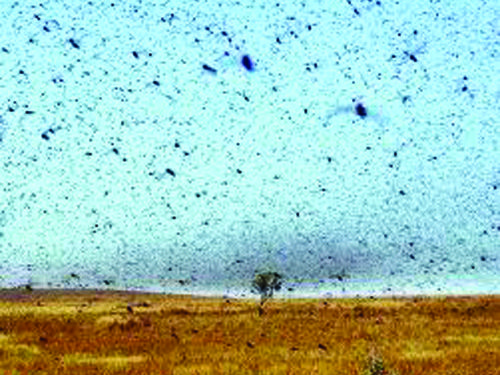NE NEWS SERVICE
NEW DELHI, FEB 6
Longer-than-usual monsoon rains across the region, especially the India-Pakistan border may have been the recent outbreak of locust in Gujarat, Rajasthan and recently in Punjab, said scientists here on Thursday.
In India, the locust outbreak – the biggest in 26 years – began late last year in Gujarat and Rajasthan states, and recently Punjab was also affected.
In Pakistan, the government declared national emergency last week to eliminate the attacking swarms of desert locusts, which were destroying crops on a large scale in the country’s Punjab province.
“The current locust outbreak is the biggest in 25 years in Ethiopia and Somalia, 26 years in India, 70 years in Kenya,” said Keith Cressman, locust forecasting officer at the UN Food and Agriculture Organisation (FAO).
“The outbreak started after heavy amounts of rains over east Africa and the Arabian Peninsula,” Roxy Mathew Koll, a climate scientist at the Indian Institute of Tropical Meteorology (IITM) in Pune added.
According to the FAO, locusts are the oldest migratory pests in the world.
These insects differ from ordinary grasshoppers in their ability to change behaviour, and form swarms that can migrate over large distances. The most devastating of all locust species is the Desert Locust (Schistocerca gregaria), according to FAO.
The locusts, which are considered to be among the most dangerous pests known to humanity, reproduce fast – 20-fold within three months, the FAO experts noted.
An adult locust can eat quantity equal to its weight daily, and just a single square kilometer of swarm can contain up to 80 million adults, they said.
Koll noted the heavy rains which drove the locust outbreak occurred due to intense storm activity sourced from the Arabian Sea during the last two seasons.
“Heavy rain triggers growth of vegetation in arid areas where desert locusts can then grow and breed,” he said.
Koll explained that recently climate change accentuated the phenomenon called the “Indian Ocean Dipole”, with warmer than usual waters to its west, and cooler waters to its east.
“On top of that, the rising temperatures due to global warming made the Western Indian Ocean particularly warm,” he said.
Cressman added that the current locust invasion in India by an unprecedented number of swarms originated in southern Iran from their breeding in spring last year.
“Summer breeding along both sides of the Indo-Pakistan border was much higher than normal due to the swarm invasion and the monsoon rains lasting one month longer than normal, allowing up to three generations of breeding,” Cressman said.
The outbreak originated from two cyclones (May and Oct 2018) that allowed three generations of breeding – from June 2018 to March 2019 — in the Arabian Peninsula, and caused an 8,000-fold increase in locust numbers, he added.
According to Cressman, this was followed by further breeding after unusually heavy rains in Iran and Yemen, and finally another cyclone in the Horn of Africa in early December 2019.
“Generally enhanced convection (cloud formation and rains) and cyclone activity follows the warm waters as they derive the energy and moisture from the ocean,” Koll explained.
As a result, he said, regions surrounding the warm western Indian Ocean – such as East Africa, Arabian Peninsula and Indian subcontinent received a lot of rains during the last two seasons.
“Along with that, the cyclone activity over the west Indian Ocean was also exceptional – we saw the largest number, and the strongest cyclones this year – releasing more rains. This might have triggered the locust outbreak,” he said.
India has not witnessed any full-blown locust cycles after 1962, however, they experts said, large-scale upsurges were observed during 1978 and 1993.
Globally, Cressman said, the current generation of swarms formed shortly after last season’s crops were harvested, but there has been considerable damage to pastures – a primary livelihood in the Horn of Africa.
“It is not only warm temperatures that favour locusts but also rainfall. The latter is not expected to occur is sufficient quantities until the start of the summer monsoon in Rajasthan which is usually in July, therefore, breeding now is not very likely in India,” he said.
“Climate models do show that the number and intensity of Indian Ocean Dipole events – like the one we saw in 2019 – are going to increase further in the future,” Koll said.












